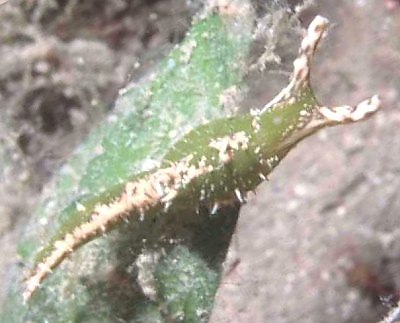
Oxynoe olivacea
Rafinesque 1819
Order: SACOGLOSSA
Superfamily: OXYNOOIDEA
Family: Oxynoidae
DISTRIBUTION
Mediterranean
PHOTO
on Caulerpa prolifera. Antalya, Turkey [Divesite: Tatlisu koyu]. Depth: 18m. Size: 35mm., September 2, 2002. Photo: Baki Yokes
This common, shelled sacoglossan feeds on Caulerpa prolifera. Since the introduction of the invasive Caulerpa taxifolia to the Mediterranean, the biology and natural history of this species has been the subject of many studies, in the hope of using it as a biological control organism. Although it will eat C. taxifolia, its preferred food remains C. prolifera.
Reference:
• Bogi, C., Coppini, M., Margelli, A. (1984) Contribution to the knowledge of North Tyrrhenean Malacofauna. La Conchiglia, 186-7: 3-7.
See separate page for full Reference List
Authorship detailsRudman, W.B., 2002 (October 2) Oxynoe olivacea Rafinesque 1819. [In] Sea Slug Forum. Australian Museum, Sydney. Available from http://www.seaslugforum.net/find/oxynoliv
Related messages
Re: Unusual sleeping behavior of Oxynoe olivacea
January 19, 2004
From: Juan Lucas Cervera
Dear Bill,
Some years ago, Cesar Megina told me that he observed a similar behaviour in aeolidaceans from the Strait of Gibraltar at night, such as Dondice banyulensis, Flabellina affinis andr F. ischitana. Thus, if you put the light of the torch in front of such nudibranchs, you could see that they were "sleeping". Then, after some minutes they started to move on the hydrozoans and to eat over them.
Regards.
Lucas.
lucas.cervera@uca.es
Cervera, J.L., 2004 (Jan 19) Re: Unusual sleeping behavior of Oxynoe olivacea. [Message in] Sea Slug Forum. Australian Museum, Sydney. Available from http://www.seaslugforum.net/find/11923Thanks Lucas,
Bill Rudman
Sleeping aggregations in Oxynoe olivacea
January 19, 2004
From: Thierry Thibaut
Dear Baki,
This behaviour is very common in Oxynoe olivacea as well with Lobiger serradifalci. I made the same observations during the 5 years I've cultivated this species in aquaria but I have also seen this behaviour in the field during night dives. I think they are mating rather than sleeping.
Sincerely,
Thierry Thibaut
thibautt@unice.fr
Thibaut, T., 2004 (Jan 19) Sleeping aggregations in Oxynoe olivacea. [Message in] Sea Slug Forum. Australian Museum, Sydney. Available from http://www.seaslugforum.net/find/11939Thanks Thierry
It would be interesting to check if they are mating. Certainly some in Baki's photos are oriented the wrong way for mating. Even if they are mating rather than sleeping, it is rather unusual for opisthobranchs to form nightly aggregations like this for any purpose
Best wishes,
Bill Rudman
Unusual sleeping behavior of Oxynoe olivacea
January 13, 2004
From: Baki Yokes
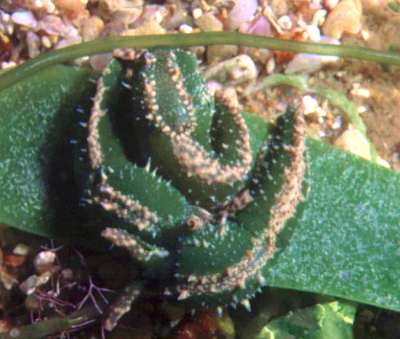
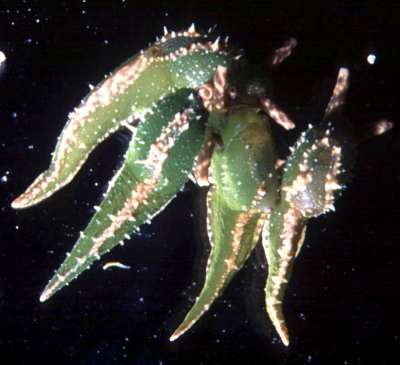
Dear Bill,
I have been observing many Oxynoe olivacea specimens for the last 9 months and this happens every night. There are usually 3-7 specimens per tank. It seems that during day time they are not interested with each other (except mating, which is about once a week). But every night they form groups of two or three, sometimes all together, and sleep side by side. At first I thought that they had fallen asleep while grazing on the same Caulerpa leaf, but then I recognized that in many of the cases they chose aquarium glass instead of a leaf, which suggests that this gathering is not happening by chance, but is a common social activity. I have not observed this kind of sleeping behavior in Elysia, Aplysia or Flabellina species I have examined so far.
Best wishes
Baki
bakiyokes@turk.net
Yokes, B., 2004 (Jan 13) Unusual sleeping behavior of Oxynoe olivacea. [Message in] Sea Slug Forum. Australian Museum, Sydney. Available from http://www.seaslugforum.net/find/11881Thanks Baki,
It will be interesting to see if anyone else has experienced a similar behaviour for either this species or other related animals
Best wishes
Bill Rudman
Re: Oxynoe olivacea from Turkey
October 7, 2002
From: Kathe R. Jensen
Dear Bill,
The transparent "feeding scar" made by Oxynoe olivacea on Caulerpa prolifera is definitely the external cell wall. But if you look around the margin of the empty part you will see a "star-like" pattern, which may be internal trabeculae, or just the way the cytoplasm forms "wound plugs".
It is characteristic that all species of Oxynoe completely empty a segment of the Caulerpa they feed on, whereas Elysias feeding on the same species of Caulerpa only leave a very small spot that is completely empty. They suck cytoplasm from a wide area, but without emptying the sement completely. This will turn yellow shortly after feeding has been completed, probably indicating that the alga retracts the remaining chloroplasts from the damaged segment.
Best wishes,
Kathe
jensen@ait.ac.th
Jensen, K.R., 2002 (Oct 7) Re: Oxynoe olivacea from Turkey. [Message in] Sea Slug Forum. Australian Museum, Sydney. Available from http://www.seaslugforum.net/find/8138Thanks Kathe,
Bill Rudman
Re: Oxynoe olivacea from Turkey
October 5, 2002
From: Kathe R. Jensen
Dear Baki,
Your report on Oxynoe olivacea feeding is very interesting. It seems to me that now you have a "one-in-a-lifetime" opportunity to study interactions between native and immigrant sacoglossans in the Mediterranean. I hope that you have or can get laboratory facilities to keep all 3 species and observe if they show different feeding rates, food preferences, growth rates, or any other interactions. This could be vital information for the people studying Caulerpa taxifolia in the Mediterranean.
I have observed the feeding in Oxynoe olivacea, and it does exactly what you describe - makes these half-circle empty marks along the margins of the blade of C. prolifera. It is difficult to explain in words, but the extrusible part of the oral tube extends around the edge of the blade, and it looks like it "wrings" the part that is emptied to get all the cytoplasm out. The other species of Oxynoe extend the extrusible parts of the oral tube all around a utricle of Caulerpa spp., and this is why they rarely (if ever) feed on C. prolifera. - Bill: C. prolifera is siphonalean like all the other Caulerpa species, but I don't know how the internal trabeculae (strings of cell wall material) are organised in this species.
Best wishes,
Kathe
jensen@ait.ac.th
Jensen, K.R., 2002 (Oct 5) Re: Oxynoe olivacea from Turkey. [Message in] Sea Slug Forum. Australian Museum, Sydney. Available from http://www.seaslugforum.net/find/8117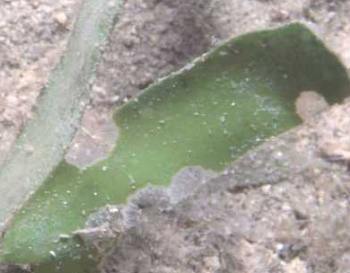
Dear Kathe,
Why I asked about the structure of Caulerpa prolifera is that in Baki's photo I can clearly see a translucent white tissue remaining in the areas in which the green materal has been eaten. I guess it is either the translucent outer cell wall which has been drained, or sucked dry, of its contents, or it is an internal skeletal structure, like the skeleton of a leaf. If the latter, then the slug would need to 'scrape' off the green plant tissue when feeding, which would be very unusual for a sacoglossan. We need to know the structure of the plant before we can try an interpret how it is feeding.
Cheers,
Bill Rudman
Oxynoe olivacea from Turkey
October 4, 2002
From: Baki Yokes

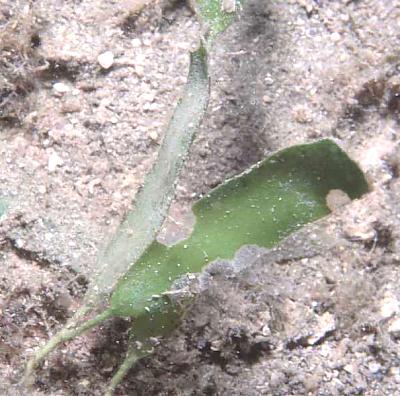
Dear Bill,
Here is a photo of Oxynoe olivacea feeding on Caulerpa prolifera. As far as I observed, the other Caulerpa-eating slugs (Oxynoe viridis and Elysia cf. tomentosa) make a puncture on the body of the algae and suck the tissue, whereas Oxynoe olivacea, like a caterpillar, eats the edges of the leaves. Although O. olivacea feeds on C. racemosa?, it usually prefers C. prolifera when it is available. I think plant morphology is one of the key elements in choosing the food.
Date: September 2, 2002
Place: Antalya, Turkey
Divesite: Tatlisu koyu
Depth: 18m
Size (O. olivacea): 35mm
Photos: Baki Yokes
Best wishes
Baki
bakiyokes@turk.net
Yokes, B., 2002 (Oct 4) Oxynoe olivacea from Turkey. [Message in] Sea Slug Forum. Australian Museum, Sydney. Available from http://www.seaslugforum.net/find/8006Dear Baki,
Thanks for these interesting photos. It is also nice to get a photo of this important Mediterranean species. I know Kathe Jensen, amongst many others, has looked at feeding in this species so perhaps she an explain how Oxynoe actually feeds on C. prolifera. From your photo it appears the transparent 'skeleton' of the plant remains after feeding. I assume that in all species of Caulerpa the colour is from the cell contents rather than from pigments in the cell wall. Which would suggest that O. olivacea does indeed remove the cell contents, but I don't know the structure of C. prolifera. Is each 'leaf' made of many tiny cells or what?
Best wishes,
Bill Rudman
